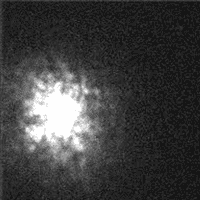Why do the Stars Twinkle?
Stars are actually very large, but they are very far away so they look small. In fact, stars are so far away from Earth that we commonly refer to them as being "infinitely" far away, which results in their looking like a "point source" of light. The only reason that we see stars at all at such enormously large distances is that they are exceptionally bright.
Starlight comes toward Earth along a path through space that produces very little change in the light. However, on Earth we see stars by looking through our planetís atmosphere, which is a thin shell of gases surrounding our planet that provide gases for breathing and insulation from the intense cold and heat of space. Our atmosphere is thin compared to the long path that starlight takes through space, but it has a dramatic effect on a starís appearance.

Contributor: Applied Optics, Imperial College
Because Earthís atmosphere is in constant motion, with pockets of hot and cold air moving around constantly, the path of light rays from a distant star are constantly being changed.
For example, light rays bend differently in cold air and hot air. The continual motion of hot and cold air pockets in our naturally turbulent atmosphere causes the light rays from a star to move continuously. In addition to this constant jitter in the apparent position of a star, the turbulent pockets of moving air also focus and defocus the starlight, making it appear to randomly change its brightness.
Both of these effects together produce the sensation that we call "twinkling" stars. If you travel outside the atmosphere and view the same stars from a space ship, you will not see twinkling. Instead, the stars will just shine steadily through the calm of space.
Contributor: Joseph Shaw









